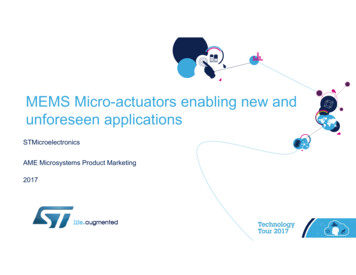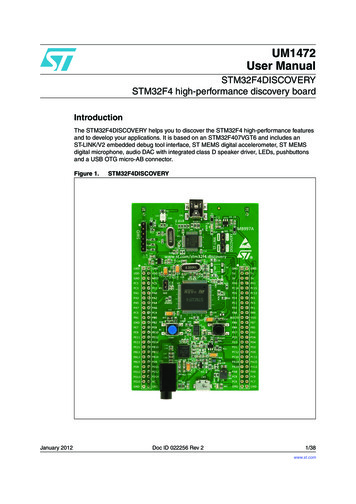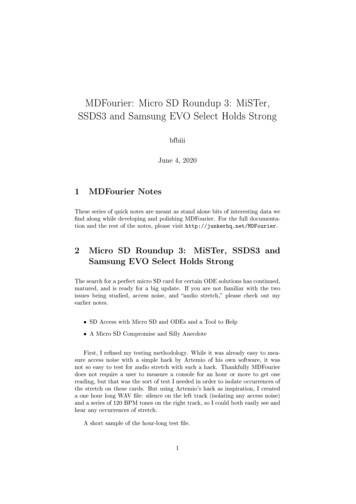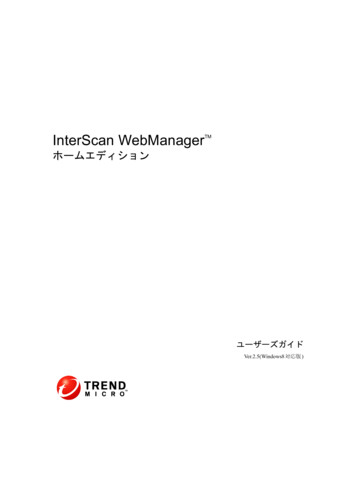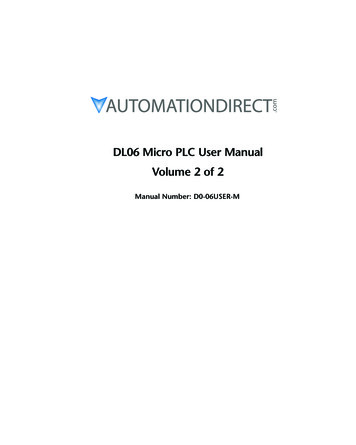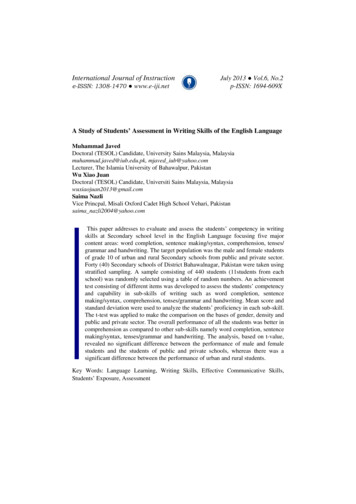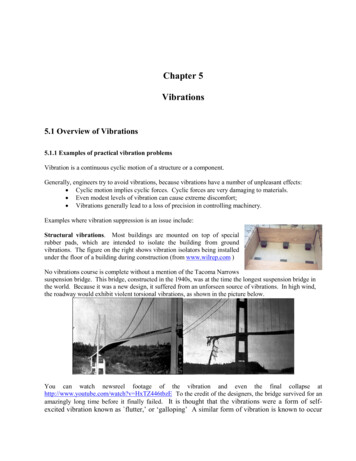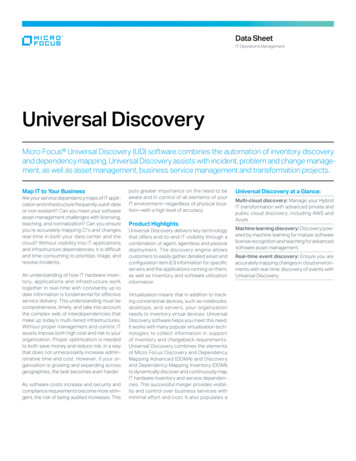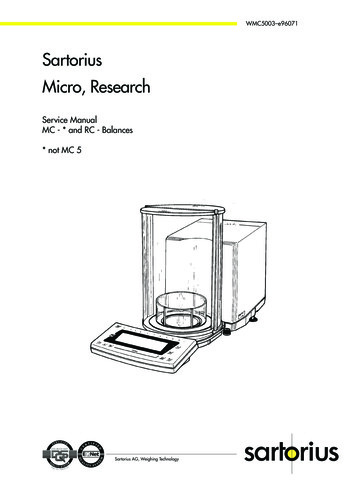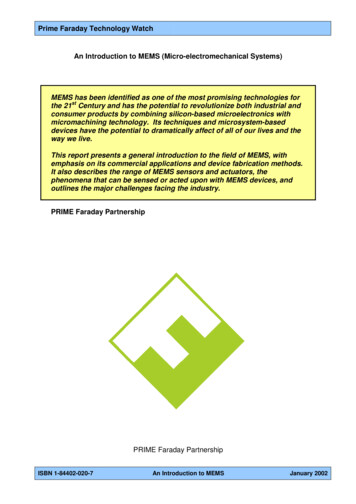
Transcription
Prime Faraday Technology WatchAn Introduction to MEMS (Micro-electromechanical Systems)MEMS has been identified as one of the most promising technologies forthe 21st Century and has the potential to revolutionize both industrial andconsumer products by combining silicon-based microelectronics withmicromachining technology. Its techniques and microsystem-baseddevices have the potential to dramatically affect of all of our lives and theway we live.This report presents a general introduction to the field of MEMS, withemphasis on its commercial applications and device fabrication methods.It also describes the range of MEMS sensors and actuators, thephenomena that can be sensed or acted upon with MEMS devices, andoutlines the major challenges facing the industry.PRIME Faraday PartnershipPRIME Faraday PartnershipISBN 1-84402-020-7An Introduction to MEMSJanuary 2002
This title is for sale in paperback at IN/1844020207Technology Watch titles are written for managers, especially in smalland medium-sized manufacturing companies. They offer a practicalintroduction to cutting-edge developments that affect – or likely soonwill affect – the design, development, manufacture and marketing ofPRIME products – products with interdependent mechanical andelectronic (and possibly software) parts.All Technology Watch titles can be downloaded free of charge fromthe Prime Faraday Partnership’s Technology Watch websitehttp://www.primetechnologywatch.org.uk/. Selected titles can bepurchased in paperback from Amazon.co.uk.In addition to market and technology reviews, the Technology Watchwebsite also provides news cuttings, case studies, an events diary anddetails of funding opportunities. The service is sponsored by the DTIand managed by the PRIME Faraday Partnership, which marries theacademic strengths of Loughborough University and the University ofNottingham to the technology-transfer expertise of Pera.
An Introduction to MEMSPublished in 2002 byPRIME Faraday PartnershipWolfson School of Mechanical and Manufacturing EngineeringLoughborough University, Loughborough, Leics LE11 3TUhttp://www.primetechnologywatch.org.uk 2002 Loughborough UniversityISBN 1-84402-020-7Whilst the advice and information in this publication is believed to betrue and accurate at the time of publication, neither the author nor thepublisher assume any legal responsibility or liability for any error oromission that may have been made.Comments on this publication are welcomed. Please send them to feedback@primetechnologywatch.org.uk Prime Faraday Technology Watch – January 2002
An Introduction to MEMSContentsPage1.Introduction . 12.Micro-electromechanical Systems (MEMS) . 12.1 What is MEMS? . 12.2 Definitions and Classifications 32.3 History 42.4 Applications . 62.4.1 Established MEMS Applications . 72.4.2 New MEMS Applications 112.5 MEMS Market 142.6 Miniaturization Issues 163.MEMS Fabrication Methods . 173.1 Photolithography 173.2 Materials for Micromachining 183.2.1 Substrates 183.2.2 Additive Films and Materials .193.3 Bulk Micromachining .203.3.1 Wet Etching .203.3.2 Dry Etching . 213.4 Surface Micromachining 213.4.1 Fusion Bonding 233.5 High-Aspect-Ratio-Micromachining . 233.5.1 LIGA . 233.5.2 Laser Micromachining 243.6 Computer Aided Design .243.7 Assembly and System Integration . 253.8 Packaging . 273.8.1 Multi-Chip Modules 283.8.2 Passivation and Encapsulation 293.9 Foundry Services 294.MEMS Transducers 304.1 Mechanical Transducers .314.1.1 Mechanical Sensors .314.1.2 Mechanical Actuators . 324.2 Radiation Transducers 344.2.1 Radiation Sensors . 344.2.2 Radiation (Optical) Actuators . 344.3 Thermal Transducers .354.3.1 Thermal Sensors .354.3.2 Thermal Actuators . .354.4 Magnetic Transducers 364.4.1 Magnetic Sensors 364.4.2 Magnetic Actuators . 374.5 Chemical and Biological Transducers 374.5.1 Chemical and Biological Sensors . 374.5.2 Chemical Actuators .394.6 Microfluidic Devices . 39Prime Faraday Technology Watch – January 2002iii
An Introduction to MEMS5.Future of MEMS . 415.1 Industry Challenges . 415.2 The Way Ahead 43References . 44Appendix A Glossary of Terms . 47Appendix B Sources of MEMS Information and Advice 49Prime Faraday Technology Watch – January 2002iv
An Introduction to MEMS1. IntroductionThis report deals with the emerging field of micro-electromechanical systems, or MEMS.MEMS is a process technology used to create tiny integrated devices or systems that combinemechanical and electrical components. They are fabricated using integrated circuit (IC) batchprocessing techniques and can range in size from a few micrometers to millimetres. Thesedevices (or systems) have the ability to sense, control and actuate on the micro scale, andgenerate effects on the macro scale.The interdisciplinary nature of MEMS utilizes design, engineering and manufacturingexpertise from a wide and diverse range of technical areas including integrated circuitfabrication technology, mechanical engineering, materials science, electrical engineering,chemistry and chemical engineering, as well as fluid engineering, optics, instrumentation andpackaging. The complexity of MEMS is also shown in the extensive range of markets andapplications that incorporate MEMS devices. MEMS can be found in systems ranging acrossautomotive, medical, electronic, communication and defence applications. Current MEMSdevices include accelerometers for airbag sensors, inkjet printer heads, computer disk driveread/write heads, projection display chips, blood pressure sensors, optical switches,microvalves, biosensors and many other products that are all manufactured and shipped inhigh commercial volumes.MEMS has been identified as one of the most promising technologies for the 21st Century andhas the potential to revolutionize both industrial and consumer products by combining siliconbased microelectronics with micromachining technology. Its techniques and microsystembased devices have the potential to dramatically affect of all of our lives and the way we live.If semiconductor microfabrication was seen to be the first micromanufacturing revolution,MEMS is the second revolution.This report introduces the field of MEMS and is divided into four main sections. In the firstsection, the reader is introduced to MEMS, its definitions, history, current and potentialapplications, as well as the state of the MEMS market and issues concerning miniaturization.The second section deals with the fundamental fabrication methods of MEMS includingphotolithography, bulk micromachining, surface micromachining and high-aspect-ratiomicromachining; assembly, system integration and packaging of MEMS devices is alsodescribed here. The third section reviews the range of MEMS sensors and actuators, thephenomena that can be sensed or acted upon with MEMS devices, and a brief description ofthe basic sensing and actuation mechanisms. The final section illustrates the challengesfacing the MEMS industry for the commercialisation and success of MEMS.2.Micro-electromechanical Systems (MEMS)2.1 What is MEMS?Micro-electromechanical systems (MEMS) is a process technology used to create tinyintegrated devices or systems that combine mechanical and electrical components. They arefabricated using integrated circuit (IC) batch processing techniques and can range in size froma few micrometers to millimetres. These devices (or systems) have the ability to sense,control and actuate on the micro scale, and generate effects on the macro scale.Prime Faraday Technology Watch – January 20021
An Introduction to MEMSMEMS, an acronym that originated in the United States, is also referred to as MicrosystemsTechnology (MST) in Europe and Micromachines in Japan. Regardless of terminology, theuniting factor of a MEMS device is in the way it is made. While the device electronics arefabricated using ‘computer chip’ IC technology, the micromechanical components arefabricated by sophisticated manipulations of silicon and other substrates usingmicromachining processes. Processes such as bulk and surface micromachining, as well ashigh-aspect-ratio micromachining (HARM) selectively remove parts of the silicon or addadditional structural layers to form the mechanical and electromechanical components. Whileintegrated circuits are designed to exploit the electrical properties of silicon, MEMS takesadvantage of either silicon’s mechanical properties or both its electrical and mechanicalproperties.In the most general form, MEMS consist ators and microelectronics, all integratedonto the same silicon chip.This is shownschematically in Figure 1.Figure 1. Schematic illustration ofMEMS components.Microsensors detect changes in the system’senvironment by measuring mechanical, thermal,magnetic, chemical or electromagnetic informationor phenomena.Microelectronics process thisinformation and signal the microactuators to reactand create some form of changes to the environment.MEMS devices are very small; their components are usually microscopic. Levers, gears,pistons, as well as motors and even steam engines have all been fabricated by MEMS (Figure2). However, MEMS is not just about the miniaturization of mechanical components ormaking things out of silicon (in fact, the term MEMS is actually misleading as manymicromachined devices are not mechanical in any sense). MEMS is a manufacturingtechnology; a paradigm for designing and creating complex mechanical devices and systemsas well as their integrated electronics using batch fabrication techniques.Figure 2. (a) A MEMS silicon motor together with a strand of human hair [1], and (b)the legs of a spider mite standing on gears from a micro-engine [2 - Sandia NationalLabs, SUMMiT *Technology, http://mems.sandia.gov].Prime Faraday Technology Watch – January 20022
An Introduction to MEMSFrom a very early vision in the early 1950’s, MEMS has gradually made its way out ofresearch laboratories and into everyday products. In the mid-1990’s, MEMS componentsbegan appearing in numerous commercial products and applications including accelerometersused to control airbag deployment in vehicles, pressure sensors for medical applications, andinkjet printer heads. Today, MEMS devices are also found in projection displays and formicropositioners in data storage systems. However, the greatest potential for MEMS deviceslies in new applications within telecommunications (optical and wireless), biomedical andprocess control areas.MEMS has several distinct advantages as a manufacturing technology. In the first place, theinterdisciplinary nature of MEMS technology and its micromachining techniques, as well asits diversity of applications has resulted in an unprecedented range of devices and synergiesacross previously unrelated fields (for example biology and microelectronics). Secondly,MEMS with its batch fabrication techniques enables components and devices to bemanufactured with increased performance and reliability, combined with the obviousadvantages of reduced physical size, volume, weight and cost. Thirdly, MEMS provides thebasis for the manufacture of products that cannot be made by other methods. These factorsmake MEMS potentially a far more pervasive technology than integrated circuit microchips.However, there are many challenges and technological obstacles associated withminiaturization that need to be addressed and overcome before MEMS can realize itsoverwhelming potential.2.2 Definitions and ClassificationsThis section defines some of the key terminology and classifications associated with MEMS.It is intended to help the reader and newcomers to the field of micromachining becomefamiliar with some of the more common terms. A more detailed glossary of terms has beenincluded in Appendix A.Figure 3 illustrates the classifications of microsystems technology (MST). Although MEMSis also referred to as MST, strictly speaking, MEMS is a process technology used to createthese tiny mechanical devices or systems, and as a result, it is a subset of MST.Figure 3. Classifications of microsystems technology [3].Prime Faraday Technology Watch – January 20023
An Introduction to MEMSMicro-optoelectromechanical systems (MOEMS) is also a subset of MST and together withMEMS forms the specialized technology fields using miniaturized combinations of optics,electronics and mechanics. Both their microsystems incorporate the use of microelectronicsbatch processing techniques for their design and fabrication. There are considerable overlapsbetween fields in terms of their integrating technology and their applications and hence it isextremely difficult to categorise MEMS devices in terms of sensing domain and/or theirsubset of MST. The real difference between MEMS and MST is that MEMS tends to usesemiconductor processes to create a mechanical part. In contrast, the deposition of a materialon silicon for example, does not constitute MEMS but is an application of MST.TransducerA transducer is a device that transforms one form of signal or energy into another form. Theterm transducer can therefore be used to include both sensors and actuators and is the mostgeneric and widely used term in MEMS.SensorA sensor is a device that measures information from a surrounding environment and providesan electrical output signal in response to the parameter it measured. Over the years, thisinformation (or phenomenon) has been categorized in terms of the type of energy domains butMEMS devices generally overlap several domains or do not even belong in any one category.These energy domains include: Mechanical Thermal Chemical Radiant Magnetic Electrical- force, pressure, velocity, acceleration, position- temperature, entropy, heat, heat flow- concentration, composition, reaction rate- electromagnetic wave intensity, phase, wavelength, polarizationreflectance, refractive index, transmittance- field intensity, flux density, magnetic moment, permeability- voltage, current, charge, resistance, capacitance, polarization [4,5,6,7]ActuatorAn actuator is a device that converts an electrical signal into an action. It can create a force tomanipulate itself, other mechanical devices, or the surrounding environment to perform someuseful function.2.3 HistoryThe history of MEMS is useful to illustrate its diversity, challenges and applications. Thefollowing list summarizes some of the key MEMS milestones [8].1950’s19581959Silicon strain gauges commercially available“There’s Plenty of Room at the Bottom” – Richard Feynman gives a milestonepresentation at California Institute of Technology. He issues a public challenge byoffering 1000 to the first person to create an electrical motor smaller than 1/64thof an inch.Prime Faraday Technology Watch – January 20024
An Introduction to MEMS1960’s19611967First silicon pressure sensor demonstratedInvention of surface micromachining. Westinghouse creates the Resonant GateField Effect Transistor, (RGT). Description of use of sacrificial material to freemicromechanical devices from the silicon substrate.1970’s1970First silicon accelerometer demonstrated1979First micromachined inkjet nozzle1980’sEarly 1980’s: first experiments in surface micromachined silicon. Late 1980’s:micromachining leverages microelectronics industry and widespreadexperimentation and documentation increases public interest.1982Disposable blood pressure transducer1982“Silicon as a Mechanical Material” [9]. Instrumental paper to entice the scientificcommunity – reference for material properties and etching data for silicon.1982LIGA Process1988First MEMS conference1990’sMethods of micromachining aimed towards improving sensors.1992MCNC starts the Multi-User MEMS Process (MUMPS) sponsored by DefenseAdvanced Research Projects Agency (DARPA)1992First micromachined hinge1993First surface micromachined accelerometer sold (Analog Devices, ADXL50)1994Deep Reactive Ion Etching is patented1995BioMEMS rapidly develops2000MEMS optical-networking components become big businessPrime Faraday Technology Watch – January 20025
An Introduction to MEMS2.4 ApplicationsToday, high volume MEMS can be found in a diversity of applications across multiplemarkets (Table 1).Table 1. Applications of MEMS [10].AutomotiveInternalnavigationsensorsAir unicationsFibre-opticnetworkcomponentsRF Relays,switches andfiltersProjectiondisplays inportablecommunicationsdevices andinstrumentationDefenceDisk drive headsBlood pressuresensorInkjet printerheadsMusclestimulators & drugdelivery systemsBrake forcesensors levisionsImplantedpressure sensorsFuel level andvapour pressuresensorsEarthquakesensorsProstheticsVoltage controlledoscillators sSplitters andcouplersData storagePacemakersTuneable lasersAircraft controlAirbag sensors"Intelligent" tyresAvionicspressuresensorsMass datastorage systemsMunitionsguidanceSurveillanceArming systemsAs an emerging technology MEMS products are centred around technology-productparadigms rather than product-market paradigms. Consequently, a MEMS device may findnumerous applications across a diversity of industries. For example, the MEMS inkjet printerhead nozzle in widespread use today has developed from a nozzle originally used in nuclearseparation. The commercialisation of selected MEMS devices is illustrated in Table 2.Table 2. Commercialisation of selected MEMS devices [11].ProductPressure sensorsAccelerometersGas sensorsValvesNozzlesPhotonics/displaysBio/Chemical sensorsRF switchesRate (rotation) sensorsMicro 1998Cost ent199820052002199820042004200520022006It is not within the scope of this report to detail all the current and potential applicationswithin each market segment. Instead, a selection of the most established MEMS devices isdetailed along with the most potentially significant future applications.Prime Faraday Technology Watch – January 20026
An Introduction to MEMS2.4.1 Established MEMS Applicationsi) Automotive airbag sensorAutomotive airbag sensors were one of the first commercial devices using MEMS. They arein widespread use today in the form of a single chip containing a smart sensor, oraccelerometer, which measures the rapid deceleration of a vehicle on hitting an object. Thedeceleration is sensed by a change in voltage. An electronic control unit subsequently sends asignal to trigger and explosively fill the airbag.Initial air bag technology used conventional mechanical ‘ball and tube’ type devices whichwere relatively complex, weighed several pounds and cost several hundred dollars. Theywere usually mounted in the front of the vehicle with separate electronics near the airbag.MEMS has enabled the same function to be accomplished by integrating an accelerometer andthe electronics into a single silicon chip, resulting in a tiny device that can be housed withinthe steering wheel column and costs only a few dollars (Figures 4 and 5).The accelerometer is essentially a capacitive or piezoresistive device consisting of asuspended pendulum proof mass/plate assembly. As acceleration acts on the proof mass,micromachined capacitive or piezoresistive plates sense a change in acceleration fromdeflection of the plates. The sense plates can be seen in Figure 4.Figure 4. (a) The first commercial accelerometer from AnalogDevices (1990); its size is less than 1 cm2 (left) [12], and (b)capacitive sense plates, 60 microns deep (right) [13].Figure 5. Modern day MEMS accelerometer (left), andthe fully packaged device (right) [12].The airbag sensor is fundamental to the success of MEMS and micromachining technology.With over 60 million devices sold and in operation over the last 10 years and operating insuch a challenging environment as that found within a vehicle, the reliability of thetechnology has been proven. An example of this success is today’s vehicles – the BMW 740ihas over 70 MEMS devices including anti-lock braking systems, active suspension, appliancePrime Faraday Technology Watch – January 20027
An Introduction to MEMSand navigation control systems, vibration monitoring, fuel sensors, noise reduction, rolloverdetection, seatbelt restraint and tensioning etc. As a result, the automotive industry hasbecome one of the main drivers for the development of MEMS for other equally demandingenvironments. Some of the leading airbag accelerometer manufacturers include AnalogDevices, Motorola, SensorNor and Nippondenso.Accelerometers are not just limited to automotive applications. Earthquake detection, virtualreality video games and joysticks, pacemakers, high performance disk drives and weaponsystems arming are some of the many potential uses for accelerometers.ii) Medical pressure sensorAnother example of an extremely successful MEMS application is the miniature disposablepressure sensor used to monitor blood pressure in hospitals. These sensors connect to apatients intravenous (IV) line and monitor the blood pressure through the IV solution. For afraction of their cost ( 10), they replace the early external blood pressure sensors that costover 600 and had to be sterilized and recalibrated for reuse. These expensive devicesmeasure blood pressure with a saline-filled tube and diaphragm arrangement that has to beconnected to an artery with a needle.Figure 6. Schematic illustration of a piezoresistive pressure sensor.The disposable sensor consists of a silicon substrate which is etched to produce a membraneand is bonded to a substrate (Figure 6). A piezoresistive layer is applied on the membranesurface near the edges to convert the mechanical stress into an electrical voltage. Pressurecorresponds to deflection of the membrane. The sensing element is mounted on a plastic orceramic base with a plastic cap over it, designed to fit into a manufacturer’s housing (Figure7). A gel is used to separate the saline solution from the sensing element.As in the case of the MEMS airbag sensor, the disposable blood pressure sensor has been oneof the strongest MEMS success stories to date. The principal manufacturers being LucasNovasensor, EG & G IC Sensors and Motorola with over 17 millions units per year. Morerecently, the technology from the blood pressure sensor has been taken a step further in thedevelopment of the catheter-tip pressure sensor. This considerably smaller MEMS device isdesigned to fit on the tip of a catheter and measure intravascular pressure (its size being only0.15 mm x 0.40 mm x 0.90 mm).Pressure sensors are the biggest medical MEMS application to date with the accelerometerMEMS a distant second. Although the majority of these accelerometer applications remainunder development, advanced pacemaker designs include a MEMS accelerometer device thatmeasures the patient’s activity. The technology, similar to that found in the airbag sensor,enables the patient’s motion and activity to be monitored and signals the pacemaker to adjustits rate accordingly.Prime Faraday Technology Watch – January 20028
An Introduction to MEMSFigure 7. (a) Disposable blood pressure sensor connected to an IV line [14],(b) disposable blood pressure sensors (as shipped) [15], and (c) intracardialcatheter-tip sensors for monitoring blood pressure during cardiaccatheterisation, shown on the head of a pin [13].iii) Inkjet printer headOne of the most successful MEMS applications is the inkjet printer head, superseding evenautomotive and medical pressure sensors. Inkjet printers use a series of nozzles to spraydrops of ink directly on to a printing medium. Depending on the type of inkjet printer thedroplets of ink are formed in different ways; thermally or piezoelectrically.Invented in 1979 by Hewlett-Packard, MEMS thermal inkjet printer head technology usesthermal expansion of ink vapour. Within the printer head there is an array of tiny resistorsknown as heaters. These resistors can be fired under microprocessor control with electronicpulses of a few milliseconds (usually less than 3 microseconds). Ink flows over each resistor,which when fired, heat up at 100 million ºC per second, vaporizing the ink to form a bubble.As the bubble expands, some of the ink is pushed out of a nozzle within a nozzle plate,landing on the paper and solidifying almost instantaneously. When the bubble collapses, avacuum is created which pulls more ink into the print head from the reservoir in the cartridge(Figure 8). It is worth noting there are no moving parts in this system (apart from the inkitself) illustrating that not all MEMS devices are mechanical.Figure 8. Thermal inkjet print technology [16].Prime Faraday Technology Watch – January 20029
An Introduction to MEMSA piezoelectric element can also be used to force the ink through the nozzles (Figure 9). Inthis case, a piezoelectric crystal is located at the back of the ink reservoir of each nozzle. Thepiezoelectric crystal element receives a very small electric charge causing it to vibrate. Whenit vibrates inwards it forces a tiny amount of ink out of the nozzle. As the element vibratesback out, it pulls some more ink into the reservoir to replace the ink that was sprayed out.Epson patented this technology but it is also used by the majority of the other leading printercompanies.MEMS has enabled more and more heating elements and piezoelectric crystals to beincorporated into a printer head. Early printers had 12 nozzles with resolutions of up to 92dpi possible. Today, modern inkjet printers have up to 600 nozzles which can all fire adroplet simultaneously enabling 1200 dpi. Epson, Lexmark, Hewlett-Packard, Olivetti, Xeroxand Canon all use a form of these MEMS in their inkjet printers. Over 350 million units weresold in 2000.Figure 9. Thermal inkjet print technology [16].iv) Overhead projection displayOne of the early MEMS devices used for a variety of display applications is the DigitalMicromirror Device (DMD) from Texas Instruments. The device contains over a million tinypixel-mirrors each measuring 16 µm by 16 µm and capable of rotating by 10º, over 1000times a second (Figure 10). Light from a projection source impinges on the pupil of the lens(or mirror) and is reflected brightly onto a projection screen. DMD’s are used for displays forPC projectors, high definition televisions (HDTV’s) and for large venues such as digitalcinemas where traditional liquid crystal technology cannot compete. MEMS has enabled themicromirrors to be only 1 µm apart, resulting in an image taking up a larger percentage (89percent) of space on the DMD chip's reflective surface, as compared to a typical LCD (12 to50 percent). This reduces the pixelation and produces an overall sharper and brighter image.Today over 30 manufacturers use the DMD (Kodak being the largest) and over 500,000systems have been shipped.Prime Faraday Technology Watch – January 200210
An Introduction to MEMSFigure 10. The MEMS Digital Micromirror Device(DMD) [17].2.4.2 New MEMS ApplicationsThe experience gained from these early MEMS applications has made it an enablingtechnology for new biomedical applications (often referred to as bioMEMS) and wirelesscommunications comprised of both optical, also referred to as micro-optoelectromechanicalsystems (MOEMS), and radio frequency (RF) MEMS.i) BioMEMSOver the past few years some highly innovative products have emerged from bioMEMScompanies for revolutionary applications that support major societal issues including DNAsequencing, drug discovery, and water and environmental monitoring. The technologyfocuses on microfluidic systems as well as chemical testing and processing and has enableddevices and applications such as ‘lab-on-a-chip’, chemical sensors, flow controllers,micronozzles and microvalves to be produced. Although many devices are still underdevelopment, microfluidic systems typically contain silicon micromachined pumps, flowsensors and chemical sensors. They enable fast and relatively convenient manipulation andanalysis of small volumes of liquids, an area of particular interest in home-based medicalapplications where patients can use devices to monitor their own conditions, such as bloodand urine analysis.One example of a new bioMEMS device is the microtitreplate on which a number of cavitiescan be simultaneously filled accurately and repeatably by capillary force (Figure 11a). This isa relatively simple MEMS product in the form of a piece of plastic with high-aspect-ratiom
magnetic, chemical or electromagnetic information or phenomena. Microelectronics process this information and signal the microactuators to react and create some form of changes to the env
